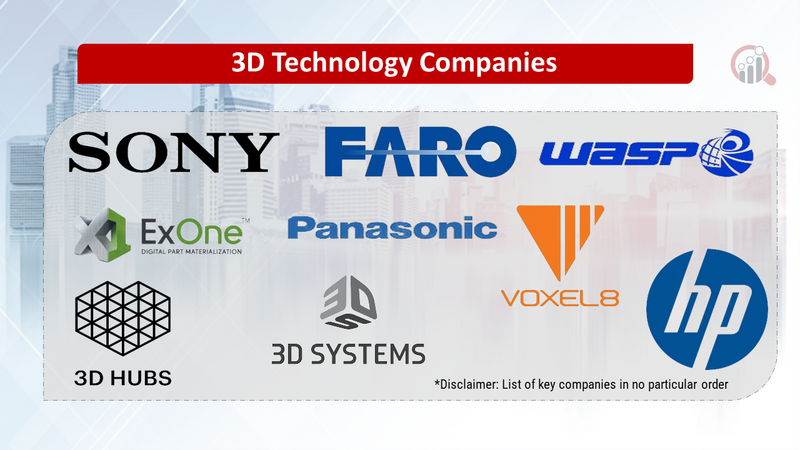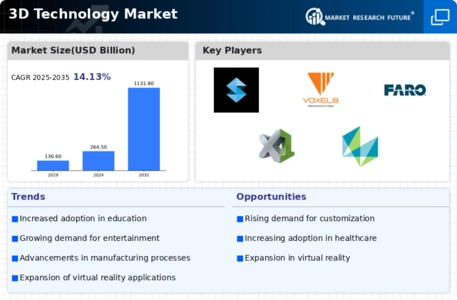Top Industry Leaders in the 3D Technology Market

3D Technology Market: Dive into the Latest News and Updates
The global 3D technology market is experiencing a seismic shift, spurred by rapid advancements and burgeoning adoption across diverse industries. From intricate 3D-printed prosthetics to immersive virtual reality experiences, 3D technologies are reshaping everything from product design to entertainment.
Some of 3D Technology Companies Listed Below:
- WASP 3D (Italy)
- 3D Systems, Inc. (U.S)
- HP Development Company, L.P. (U.S)
- 3D Hubs (Netherland)
- Sony Corporation (Japan)
- Voxel8, Inc. (U.S)
- Panasonic Corporation (Japan)
- Faro Technologies, Inc. (U.S.)
- ExOne (U.S)
- Hexagon AB (Sweden)
Strategies adopted by these players are multifaceted:
-
Product Innovation: Continuous development of advanced 3D printers, faster software algorithms, and more accessible materials. -
Industry Collaborations: Partnering with leading companies in healthcare, aerospace, and other sectors to accelerate 3D technology integration. -
Strategic Acquisitions: Merging with smaller companies to tap into new markets and expertise. -
Open-Source Initiatives: Encouraging open-source software development to foster innovation and wider adoption.
Key factors influencing market share analysis include:
-
Technological Advancements: The rate of innovation in 3D printing hardware, software, and materials. -
Industry-Specific Applications: The rise of new and niche applications driving demand in sectors like healthcare, aerospace, and consumer goods. -
Regulation and Standardization: Evolving regulations and the establishment of industry standards influencing product development and adoption. -
Geographical Distribution: Growth potential in various regions, with Asia Pacific and North America currently leading the market.
New and emerging companies are constantly disrupting the landscape:
-
Desktop Metal: Pioneering binder jetting technology for faster and more affordable metal 3D printing. -
Carbon: Revolutionizing additive manufacturing with continuous composite 3D printing technology. -
Formlabs: Democratizing 3D printing through affordable and user-friendly resin printers.
Current company investment trends reveal a focus on:
-
Research and Development: Expanding capabilities and pushing the boundaries of 3D technology. -
Vertical Integration: Gaining greater control over the entire supply chain, from materials to software. -
Subscription-Based Services: Shifting towards recurring revenue models through software subscriptions and cloud-based solutions. -
3D Printing-as-a-Service (PaaS): Offering on-demand 3D printing services to cater to diverse customer needs.
Latest Company Updates:
February 10, 2024:
-
Focus on bioprinting advancements: Printing human tissue and organs for transplantation and drug testing continues to make strides. -
Ethical considerations and regulatory hurdles remain challenges in bioprinting.
February 24, 2024:
-
Rise of metal 3D printing in aerospace and automotive industries: Lightweight and customized components improve fuel efficiency and design complexity. -
Challenges in quality control and material certification for metal 3D printing.
March 7, 2024:
-
Growing adoption of 3D printing for construction: Printing houses and buildings on-site offers potential for faster and more sustainable construction. -
Challenges in scalability, safety regulations, and material durability for widespread construction 3D printing.

